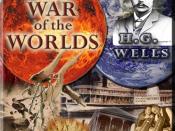In ``War of the Worldsôô H.G. Wells makes excellent use of the Artilleryman in describing society. One of the novelÃÂs major themes is the society and the presence of the Artilleryman demonstrates the attitudes of society during the Martian invasion. The Artilleryman is very significant as he represents the military and the government. The artillery is the backbone of every army as the eventual outcome of all wars depended on firepower, which is in the domain of the ArtillerymanÃÂs occupation. The government influences society to the extent that it is indoctrinated by the government. H.G. Wells makes the Artilleryman appear very persuasive and him being a superb orator and this results in the mindless appeal to the government by society. The Artilleryman appears twice in the novel.
The first appearance of the Artilleryman is made in Book one, Chapter eleven. The Artilleryman is there described as ``àdimly clambering over the palings.ôô
by the narrator. In this appearance, the Artilleryman is representing the military and H.G. Wells shocks the reader in describing the military as ÃÂdimÃÂ and ÃÂclamberingÃÂ. The military holds immense amounts of prestige and honor by society; most notable examples are the British army and the Prussian army. Britain has been one of the worldÃÂs leading military powers since 1763 and its military was fundamental for colonization and ultimately significant in achieving the greatest Empire in the world. Wells traces the military in a negative image and points out that there is no honor in the military as its soldiers are just human beings who are ÃÂdimÃÂ and ÃÂclamberingÃÂ. The quotation makes a mockery out of society, because society believes that there is honor in the army because of its ÃÂmiraculousÃÂ achievements in obtaining an empire, but H.G. Wells repeatedly gives reference to the ÃÂHeat-rayÃÂ as being the...


